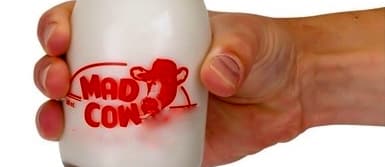In announcing the detection of a new case of mad cow disease in California, the USDA emphasized that her carcass never made it into the food supply. The fact that the infected animal was a dairy cow, though, raises the question about the disposition of her milk. There’s currently no direct evidence that cow’s milk poses any mad cow risk, but when it comes to this mysterious class of diseases, we’ve learned time and time again that absence of evidence of risk, does not equal evidence of absence of risk.
The USDA flatly declared that milk doesn’t transmit mad cow disease, but that’s what we used to think about scrapie, the parallel disease in sheep, before research in the last 5 years unequivocally demonstrated that milk could indeed become contaminated with prions, the infectious proteins that cause these transmissible sponge-like (spongiform) brain diseases (encephalopathies). Similar experiments have not detected infectivity in mad cow milk, but this may be a function of the limited sensitivity of testing methods. And we have no such data on the atypical strain of mad cow disease found in California, which research suggests is more “lymphotrophic,” meaning more likely to invade the lymph system, which could mean mean milk is more likely to become infected.
If prions are present at low levels in bovine milk, then this could present a particular problem in the United States, since inflammation has been shown to dramatically boost the infectivity of prion-infected milk and there is an epidemic of mastitis in the U.S. dairy herd. Last year researchers demonstrated that the ingestion of as little as 1 to 2 quarts of milk from scrapie-infected sheep stricken with mastitis could cause prion infection in lambs at an attack rate of 86%. This is thought to be because the prions may concentrate in the blood and pus cells sloughed into milk from inflamed udders.
Today’s dairy cows endure annual cycles of artificial insemination, pregnancy and birth, and mechanized milking for 10 out of 12 months (including 7 months of their 9-month pregnancies). This excessive metabolic drain overburdens the cows, who are considered “productive” for only two years and are slaughtered for hamburger when their profitability drops, typically around their fourth birthday, a small fraction of their natural lifespan. Turning dairy cows into milk machines has led to epidemics of so-called “production-related diseases,” such as lameness and mastitis, the two leading causes of dairy cow pre-slaughter mortality in the United States.
Because 1 in 6 dairy cows in the United States suffers from mastitis, the dairy industry continues to demand that American milk retain among the highest allowable “somatic cell” concentration in the world. When a cow’s udder is inflamed, greater than 90% of the somatic cells in her milk are neutrophils, the inflammatory immune cells that form pus. As the dairy industry points out, the accumulation of pus is a natural part of an animal’s defense system. So pus itself isn’t a bad thing, we just may not want to drink it, especially if it can increase the risk of transmission of cellular pathogens that can survive pasteurization such as paratuberculosis and, in theory at least, prions.
-Michael Greger, M.D.
See also:
